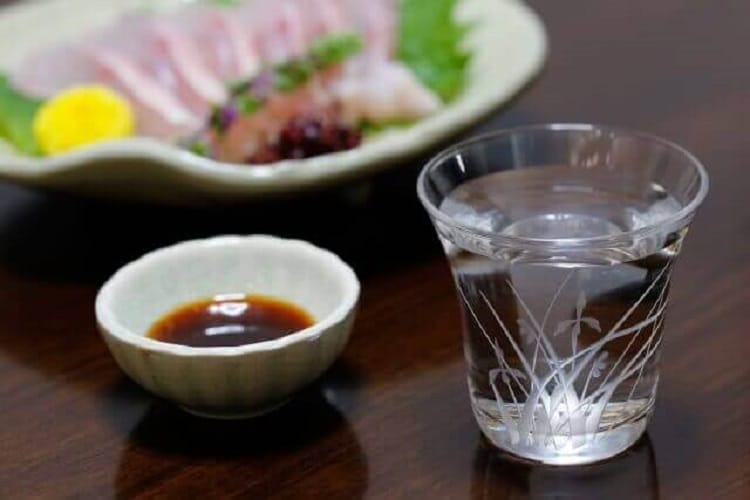
“I want to choose foods and snacks that are perfect for sake” and “I want to taste the best sake”.
It is a wish that everyone has, but even so, the hurdles may be quite high. Certainly some information is certainly written on the label.
But for those who do n’t drink much,Which Japanese sake and which dishes should be combined?Isn't it a place to worry a lot?
That ’s where it helps.Classify sake into four typesIt is a technique. Many people may be wondering, “Whether sake is abundant in variety but can only be divided into 4?” “I have learned that there are also 8 types of specially named sake?”
Then, I will introduce in detail below!
What is the “21,000 type taxonomy” achieved by tasting 4 types of sake?
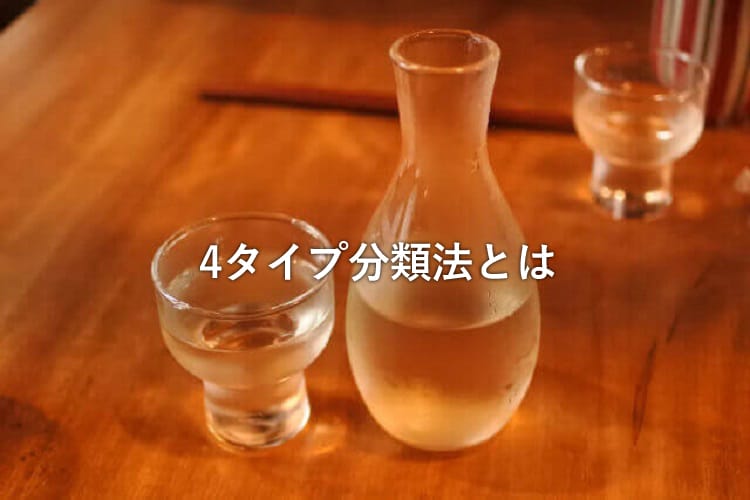
Of sakeThe “4-type classification method” is a method proposed by the “Sake Service Study Group / Sake Study Group Association (SSI)”.
SSI is an organization established with the aim of inheriting and developing Japanese sake and food culture through comprehensive research and enlightenment activities on alcoholic beverages, focusing on how to provide Japanese sake, “Sake” and “Shochu”. This is also used for accreditation of qualifications for the sake maker.
SSI spent several years working on research to find an easy-to-understand way of providing sake.
I arrived after tasting 21,000 kinds of sake,Conclusion that `` Japanese sake can be classified into 4 types according to aroma and taste ''is. This taxonomy is now widely used in restaurants.
The four types by SSI are categorized as follows.
・ Soushu: A light and refreshing type
・ "Jinshu": rich taste type
・ "Jukushu": Aged mature type
The kanji, such as “漢”, “Sou”, “醇”, and “ripe”, somehow convey the image. Let's take a closer look at the features of each 4 type.
"Features" of each 4 type
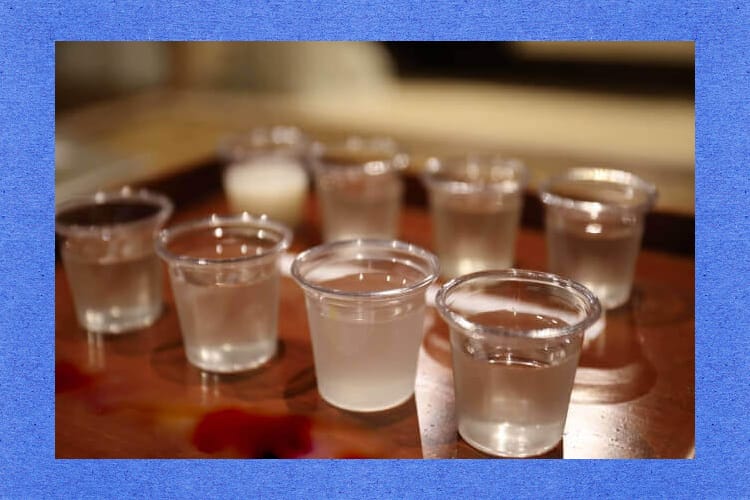
① Sake
·fragrance:Gorgeous fragranceIs the biggest attraction of sake. It has a sweet fragrance that you can't imagine from sake, such as bananas, apples, peaches, pears, melons, and lychees, and fragrances like violets, lotus, white roses, and cherry blossoms. Give me.
・ Taste:The juicy, elegant sweetness and beautiful transparency make it an elegant beauty.is. There are various types from light to dark.
・ Color: Colorless to pale
-Applicable sake:Sake with a gorgeous and fruity fragrance called Ginjo-kaIs mainly true. Many of the items labeled “Ginjo” such as “Junmai Daiginjo Sake”, “Daiginjo Sake”, “Daiginjo Sake”, and “Ginjo Sake” correspond to this type of sake.
② Refreshing sake
·fragrance:A modest and neat scentIs a characteristic. Citrus fruits such as citrons, lemons, grapefruits, limes and oranges, herbs such as rosemary, thyme, and dill, and the scent of green leaves such as trefoil and persimmon create a pleasant refreshing sensation.
・ Taste:The acidity is mild. Light and light, refreshing and refreshingIs a feature.
・ Color: Colorless to pale
-Applicable sake: brewed alcohol is added"Main brewing sake" "Ginjo sake" "Sake"Not fired"Drink",in additionLow alcohol type sakeEtc. are often seen in this refreshing sake type.
③ Sake
・ Scent: Reminiscent of raw rice and rice bran itselfThe plump and calm aroma is exactly the origin of sake. Heal the drinker's heart gently. There are scents of freshly made rice cakes, rice confectionery, dairy products such as high-quality yogurt, fresh cream, and fermented butter. Others are reminiscent of shimeji mushrooms, shiitake mushrooms, and white mushrooms.
・ Taste:Rich taste that makes you feel the richness and sweetness of riceIs a feature. The aftertaste is firm and you can enjoy the lingering lingering taste that lasts a little longer.
・ Color: slightly yellowish
・ Applicable sake: “Pure Rice Sake” and “Special Junmai Sake”Japanese sake using rice with a high percentage of rice and rice bran or not well polishedIs true. In particular, sake brewed in “ginger-based liquor mothers” such as ginger and mountain ruins are more likely to fall under this type of sake.
④ Ripe sake
・ Aroma: Reminiscent of nuts, dried fruits, maple syrup, spices, etc.Excellent condensed fragrance. A unique, refined scent like caramel sauce is often compared to Chinese Shaoxing liquor.
・ Taste:A powerful flavor that combines a rich, rich and thick sweetness and a rich sense of volumeIs attractive. It has a high viscosity and is engrossed in a smooth texture that is reminiscent of silk. A major feature is that the reverberation lasts very long.
・ Color: golden or scarlet
-Applicable sake: "Long-term aged sake" "Old sake"Aged for a long timeIs categorized into this sake
Delicious “temperature” of each of the 4 types
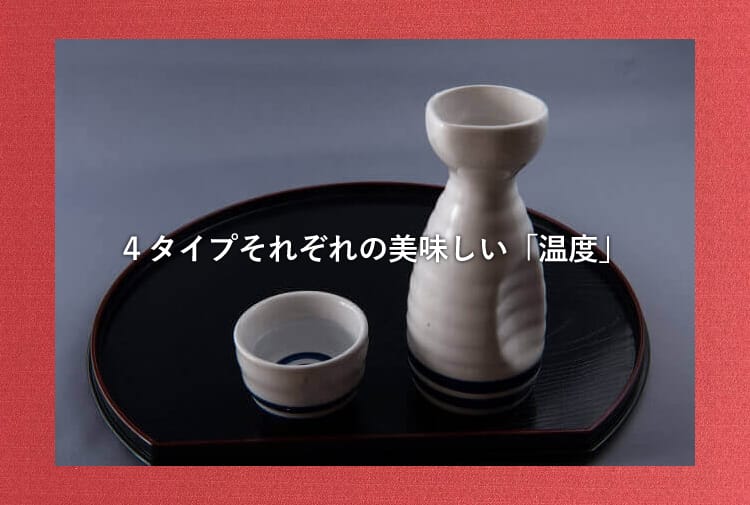
① Sake
Recommended drinking temperature: around 10 ℃ (8 ~ 15 ℃)
Refreshing feeling improves by chilling,If it is too cold, it will be difficult to feel the gorgeous fragrance.
If you want to fully enjoy the fruity fragrance unique to sake, 10 ℃ is the best. If you feel a little sweet, it will turn into a sharper taste if you cool it a little more.
Basically, this sake is delicious when you drink it cold.If the fragrance is mild and the umami is firm, you can use it as a slimy bowl with a temperature of about 40 ℃..
② Refreshing sake
Recommended drinking temperature: 5 ~ 10 ℃
This type is characterized by a refreshing taste that is light and refreshing,Taste comes to life by cooling firmly.
If you want to fully enjoy the light feeling,It is recommended to cool down to about 5 ℃.
③ Sake
Recommended drinking temperature: 15 to 18 ℃, or 40 to 55 ℃
This sake has the widest temperature range, from room temperature to over 55 ° C. This type shows various changes depending on the product temperature.
It is better to drink at a slightly higher temperature in order to extract plenty of rich and delicious ingredients.It will be.
④ Ripe sake
Recommended drinking temperature: 15 to 25 ℃ or around 35 ℃
There are a variety of types, ranging from profound to innocent, so it is best to set the temperature according to each type.
If it has a heavy umami ingredient, drink it at a higher temperature, if it is a lighter type, drink it at a lower temperatureAnd each taste comes to life.
If you want to make a bowl, the balance may be lost if the temperature is too high,Try to make it a little lowerAnd good.
The liquor that has a unique aroma and taste over time has a tendency to like and dislike a lot depending on the drinker.If you are not good at it, set the temperature slightly lower.Then, you can suppress the unique strong flavor, so it will be mild and easy to drink.
"Cooking" excellent compatibility with each of the four types

① Sake
This sake is also perfect as an aperitif that can be enjoyed alone. Because it is gorgeous and fruity, the aroma is clear,I tend to choose food.
Recommendations include pale and light ingredients with natural and soft sweets and dishes using fruits..
The cooking method is not to impair the fruity aroma and refreshing feeling of sake.Simple things like steaming, baking or rawyou know.
② Refreshing sake
This refreshing sake is multiplayer because it has a moderate aroma and is light and refreshing.
Basically, it ’s better to combine it with lighter dishes.. In addition, the sharp drinker cleanses the greasy, so it is also ant to combine this refreshing sake with a cooked dish.
The cooking method isSimple things like steaming, baking, raw.
③ Sake
This sake also has a good affinity with various dishes.Among them, the best is a well-flavored dish or a sake-based dish..
In addition, ginger-based sake such as ginger and mountain ruins with a creamy taste derived from lactic acid bacteria matches well with Western-style dishes using dairy products such as butter, cream, and cheese.
The cooking method isBake, boil, fry, fry, etc.. Finishing with a deeper taste will balance the taste of this sake.
④ Ripe sake
Because it has a very complex and heavy flavor,The range of dishes that can be combined is never wide.
Instead, you can enjoy a combination of dishes that you can't imagine with the other three types.
The unique “condensation” and “ripening” with a rich taste and aroma are highly sweet with honey, etc., rich with fat such as foie gras, and strong ingredients and cooking ingredients..
It also goes well with dishes using dried foods such as dried fruits, dried fish, dried boletus and dried shiitake. The cooking method isBake, fry, boil, and sardineetc.
Also, the sake is actuallyAfter dinner drinkIt's also cool. Perfect with desserts and strong cheeses.
"Sakeware" that brings out the individuality of each of the four types
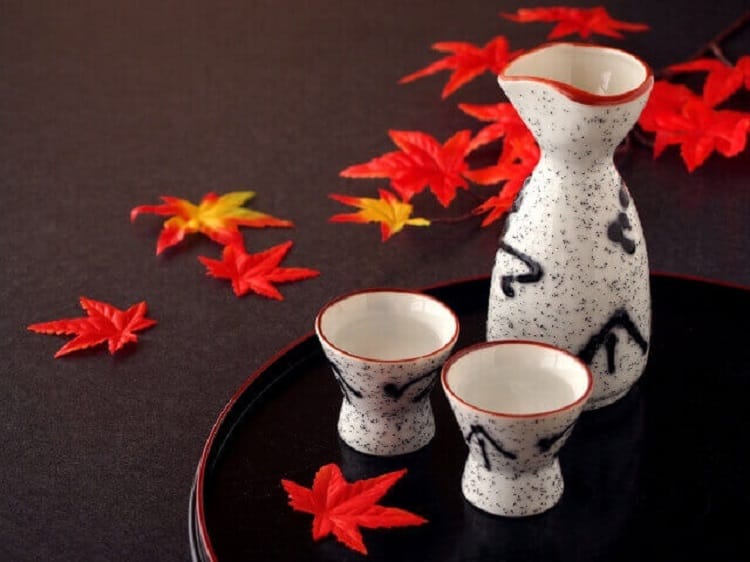
① Sake
To choose a sake bottle for sake,The highest priority is to make full use of the fruity fragrance and juicy taste that are great attraction..
To keep the fragrance that stands up for a long time,A wide space and narrow aperture type are best..
The perfect shape is a balloon-shaped bowl with a large bulge.Burgundy wine glass.
Also, Riedel (Austria), a prestigious wine glass brand, developed for Daiginjo in 2000."Ridel O Daiginjo Glass"Is also recommended. You can enjoy the fruity fresh fragrance in the shape of a vertically long bowl.
② Refreshing sake
For refreshing sake with a light and simple taste,Small flute and long flute glass are perfect.
The sake will flow straight from the tip of the tongue, so the lightness will stand out. Because I often drink at cold temperatures,Small size sake bottle is good so that you can drink it before the temperature risesIt will be.
Glass made of metal such as tin or titaniumThen you can keep the cold. Also,Bamboo liquor and cut glassThen, it gives a cool impression, so these are also recommended.
③ Sake
The sake that tastes like rice and has the flavor of rice.If you choose a sake bottle with a wide caliber, such as flat rice cake, you can fully enjoy the deliciousness and richness..
Also, because the fragrance is modest, the length is low,It is OK to drink it with your face down and your nose closeis. To relax and enjoy it, sake bottles that give a Japanese impression are perfect.
It's nice because you can stick to one-sided or pottery and produce a cool and nice atmosphere. A Japanese atmosphere has been created, and it is guaranteed that not only Japanese but also foreigners will be pleased.
④ Ripe sake
In order to enjoy the condensed fragrance brought about by aging obtained from long years,A large bowl is good.
Like a brandy glassIt is recommended to choose a sake bottle with an extremely curved shapeis. However, since the scent is strong enough, you can of course enjoy the scent in a small liquor like sherry glass or shot glass.
It's a mature sake with a lot of deep fans, but it is also true that beginners who haven't swallowed much have the opinion that they are not good at aging aromas.
SuchFor beginners, the wide-bore flat type is GOOD. Because the fragrance is easy to volatilize, the fragrance is mellow and easy to drink.
It is also important to make use of beautiful colors such as golden and scarlet. You can fully enjoy the rich and brilliant shades of transparent glasses and cut glasses.
In addition, the lacquerware with gold inside is also wonderful because it gives off a high-class feeling.
